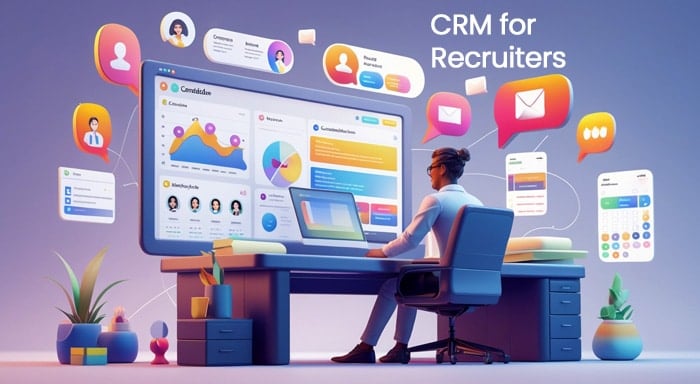CRM for Recruiters helps businesses handle all facets of recruitment and staffing. It empowers businesses to develop and manage relationships with a vast range of candidates. Ultimately, it is an effective solution to streamline the entire hiring process. All professionals working in talent acquisition know the significance of a recruitment CRM. Normally, the full form of CRM is customer relationship management. However, in the context of recruitment, the full form of CRM is candidate relationship management, clearly underlining its purpose and function.
These CRM platforms are not one-fits-all solution, and the features vary from one platform to another. In this comprehensive guide, let us know all the fundamentals related to CRM for recruiters. You will easily understand the succeeding sections if you are already familiar with the fundamentals of CRM (customer relationship management) such as what is CRM, features of CRM, benefits of CRM, applications of CRM, etc.
What is CRM for Recruiting?
A Candidate relationship management is a software platform that recruiters utilize to attract, nurture, and foster relationships with the candidates throughout the process of recruitment and beyond. The platform is leveraged for establishing and building strong relationships with candidates. It not only helps in attracting top talent from the industry but also boosts the brand of the company in the job market.
In simple terms, it is a simple tool to streamline the entirety of the recruitment process and recruiter’s interaction with the candidates. Having an effective tool in place allows companies to go beyond than focus on filling an empty position in the company. It empowers the HR department to concentrate on finding candidates who easily align with the mission, values, and culture of the organization.
Functions of Recruitment CRM
CRM for recruiters performs a variety of functions to make the hiring process simple and effective for the organization. The common functions of such a CRM are explained in the following points:
Handing the Recruitment Process:
The most standard and foundational function of the platform is managing the recruitment process. It allows the recruiters to synchronize the applicant tracking system or upload applications to the candidate relationship management tool. This ensures that the talent acquisition team has a centralized tool to organize candidates and make notes on each candidate. Every role that recruiters are hiring for is streamlined in its specific project. Thus, it helps recruiters to seamlessly find the candidate they are looking for within seconds.
Additionally, you can also interact with these candidates with the help of this tool. You can also preview the communication history to personalize your interaction with them and boost their interest in joining your company. Many of these CRM can also be integrated with the career page of your website to provide key analytics and insights.
Automating Hiring
CRM for recruiters has evolved a lot in the last 20 years. It has transformed significantly during this time. Nowadays, nearly all CRM tools for talent acquisition offer some level of automation. The common automation features found in the platform are as follows:
Automated Screening of Resumes: The tool helps in the automated screening of candidates, which can take hours if done manually by the recruiters. The tool can figure out within seconds whether the candidate is fit for the role based on the keywords mentioned in the job description.
AI Sourcing: Screening of candidate profiles via diverse web sources to find the right fit for the role. CRM leverages AI algorithms that analyze Boolean searches and job descriptions to screen candidates.
Automating Outreach: Automated generation of texts, emails, LinkedIn InMails, etc. Recruiters can also schedule these messages over a specific period.
Nurture Candidates: By sending automatic emails, you can keep the candidates interested so that they remain available for your position.
Creating Recruitment Analytics: You can collect insights from the recruitment analytics to further improve their offer acceptance rates. Using such advanced analytics can empower businesses to upgrade their application stage, interview process, and salary negotiation.
Recruitment analytics involve data from career page analytics, outreach analytics, monitoring recruitment KPIs, etc. It provides recruiters a bird’s eye view on open rates, response rates, application rates, screen to interview rates, career page visits, percentage of qualified candidates.
Chatbots: Recruiters can adopt chatbots to ensure 24/7 availability for the candidates. This makes sure that candidates have something to interact with even if there is no staff available. Companies can create a first line of response for the candidates, perform initial screenings, and offer tailored guidance. This shows the high responsiveness of the employer and creates a good impression on the candidate.
Applicant Tracking System vs Recruitment System
Before CRM for recruiters became popular, companies used to rely on ATS. In the recruitment process, both ATS and CRM can be useful and serve distinct and complementary purposes. The following two points offer the difference between CRM and ATS in term of main purpose and use cases:
Core Purpose:
ATS: Mainly, ATS emphasizes simplifying the recruitment process for open positions and management of active applications. It is purpose-built for arranging resumes, managing applications, and monitoring candidates throughout the recruitment process.
Recruitment CRM: It puts strong emphasis on developing and fostering relationships with qualified candidates right before they even apply for the job. It enables recruiters to personalize interaction with passive talent and ensure a talent pool to serve hiring needs in the future.
Use Cases:
ATS: The main purpose of an ATS is to be a beginning point for open requisitions. You can then advance the profile on career sites or job posting sites and collect various applications. Manually, then, you can screen candidate resumes and shortlist candidates. From there, you will see all the details regarding the candidates.
You can see if there are any notes on the candidate or whether the interview has been scheduled or not. Using an ATS, you can also select or reject a candidate for the next round. ATS also helps recruiters get a unified place to determine how many candidates have received, accepted, or rejected the offer letter.
Recruiting CRM: While an ATS will always play a vital role at the time of selecting or rejecting a candidate, the CRM is quite crucial for handling the in-between processes. CRM offers automated processing to screen resumes, which can save a substantial amount of recruiters’ time. Using previous interactions, you can also find out whether the candidate has applied for the same position before.
Additionally, you can also streamline your sourcing efforts, develop and foster pools, find talent, centralize candidate data, and engage clients through personalized interaction. Essentially, you can integrate your ATS with CRM to simplify your hiring efforts.
Conclusion
The days of managing recruitment process with only ATS, email, and spreadsheets are long gone. Not only is this method time-taking and prone to errors, but it is also inefficient for recruiting agencies and enterprise-level hiring processes. Incorporating CRM for recruiters helps employers streamline their hiring process, minimize manual workload, centralize candidate data, automate processes, and personalize interactions. With CRM, you get advanced analytics that help you extract valuable insights to enhance your hiring process.
For more blogs on automation, data management, and customer relationships management, check out our website.
Also Read
Role of CRM for Manufacturing Companies
Understand CRM for Startups: A Comprehensive Guide to Scale Faster
Author’s Bio

Hello, I am Ashish Dwivedi. I am a core CRM developer with 15+ years of experience in delivering efficient CRM solutions that drive business growth and efficiency. I specialize in creating extensions for SuiteCRM and SugarCRM. My most notable extensions include SuiteCRM Email to Lead, SugarCRM Mailchimp, and SuiteCRM BCC Archiver. I also have a CRM of my own called OutRightCRM.



